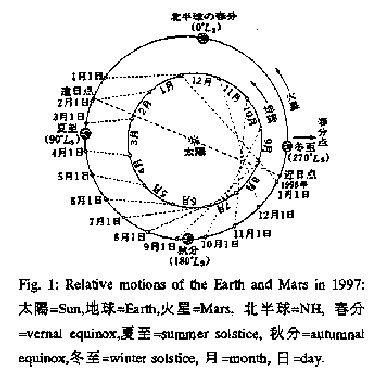
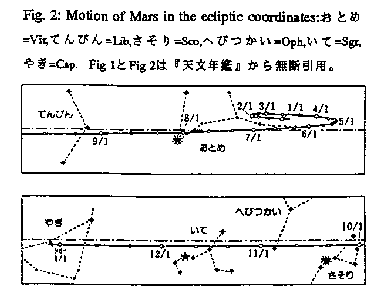
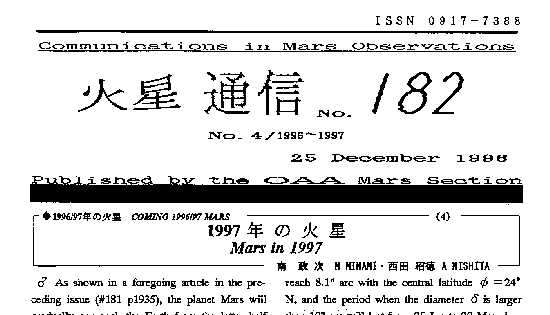 CMO #182
CMO #182
- From #182 we cite 3 articles -
.. Index ........
* OAA MARS SECTION
-- Mars Observation Reports of 1996/97 (#004)--
* Coming 1996/97 Mars (4)
-- Mars in 1997
* 10 Years Ago (12)
-- CMO #022(10 November 1996) and #023(25 November 1996) - (Japanese)
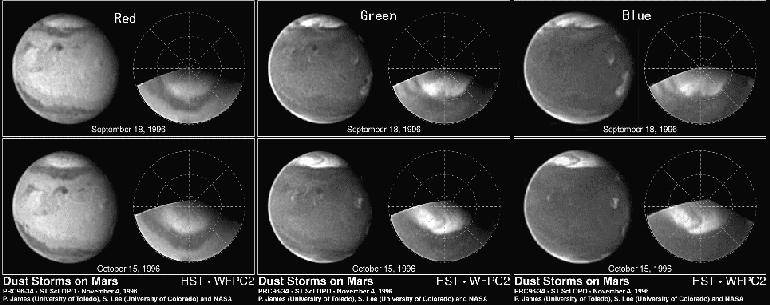
As shown in a foregoing article in the preceding issue (CMO #181 p1935),
the planet Mars will gradually approach the Earth from the latter half of
1996 and the will be closest to the Earth on 20 March 1997 at 17hGMT when
the Martian season is at 093 degrees of Ls just after the summer solstice of
the northern hemisphere, and thereafter it will gradually go away.


Figure 1
depicts the relative motions of the Earth and Mars on their orbits in 1997,
and it shows that the shortest distance will be attained at a point between
1 Mar and 1 Apr. Note that the closest day is this time
slightly away from the aphelion of Mars. Figures 1 and 2 are cited from p115
of the 1997 Tenmon Nenkan (Astronomical Almanac) published by the Seibundo - Shinkosha Publ. Co., Tokyo. The Tenmon Nenkan has been published every year
since 1948 (the present volume is thus the 49th). The part concerning Mars
has been written and figured these years by M MINAMI and A NISHITA.
Figure 2 shows the celestial motion of Mars among the constellations in an ecliptic coordinate. It clearly shows how the planet makes a loop at the western part of the constellation Virgo.
The article in the Tenmon Nenkan also roughly summarises the ephemeris and gives a guide for the observation of the planet Mars in 1997: On 1 Jan the apparent diameter will reach 8.1 arcsecs with the central latitude 24 degrees N, and the period when the diameter is larger than 10 arcsecs will last from 25 Jan to 20 May during which the season will proceed from 070゜ degrees of Ls to 120 degrees of Ls. The period around 080 deg of Ls in mid- Feb is especially cautioned: the perimeter of the north polar cap should be carefully observed. The apparition diameter will be then 12.4 arcsecs. Eastern quadrature will occur on 23 June (JST), and the app diameter will be 7.8 arcsecs with the season 137 deg of Ls, and so on.
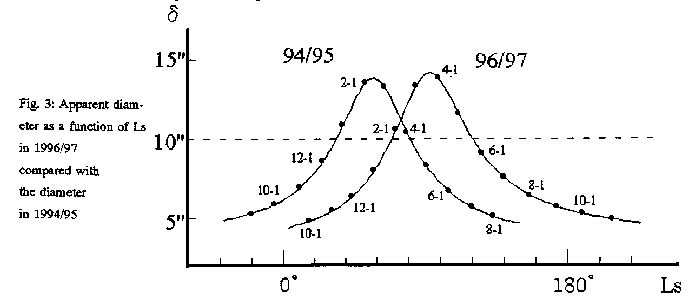
The article has two other figures (Fig 3: a series of disks having abbreviated grids with the size of npc, and Fig 4: a fan-formed map of the Martian northern hemisphere with nomenclature) but here omitted. Instead as a new figure we show here as Fig 3 how the apparent diameter will change in 1996/97 as Ls proceed, in comparison with the change of the diameter in 1994 /95. The season retards this apparition about by 30 degrees in Ls compared with the preceding case, and as noted already in the preceding issue, the diameter exceeds the maximal one in 1995 for about 20 days (about 10 degrees in Ls).
It is also interesting here to compare a bit the status of the present apparition with that in 1981/82 because it is sometimes said that the present apparition is similar to that in 1981/82. This is not quite the same. In 1982, the planet Mars was closest to the Earth on 5 April 1982, and the season was 105 deg Ls, and so there is a difference of season by 13 degrees in Ls. The apparent diameter was also then 14.7 arcsecs rather lager than the present one. The central latitude was 22 deg N. The same difference of season also occurred between the previous apparitions in 1995 and 1980 (the planet was closest on 11 Feb 1995 at 058 deg Ls while in 1980 on 26 Feb at 071 deg Ls, differing by 13 degrees).
One possible similarity will be that we can watch the same region on the Martian surface around at the opposition days. In Japan the area from Arcadia through Propontis I to Cebrenia will be watched and the results will be readily compared with those obtained in 1982 with 13 degrees- in -Ls difference of season.
(Japanese)
この年の火星は十一月28日に「東矩」となって、夕方の南の空に0等級で光っていた。足早に順行をしていて十二月初めには「みずがめ座」へ入って赤緯があがってきた。遠ざかりながらも沈む時間は余り変わらず、まだ夜半前の観測対象だった。しかし視直径は10秒角を割り込んで、すでに観測終盤であった。Lsは十二月初めには、南半球の夏至を遙かに過ぎた290゚になり、1972年のSolis L大黄雲発生と同じ時期が近付いていた。最早、大規模な現象しか捉えられない視直径となっていたが、十一月下旬には回ってきたSolis L 付近が注視された。
OAA Mars Sectionには、この期間と追加の報告が南政次氏、張麗霞氏、岩崎徹氏、中島守正氏、阪部幹也氏の諸氏から寄せられている。
この期間観測された事として、Solis L辺りは常に薄暗く見えていた事。またNoachis、Hellas辺りも正常に見えていて、大きな異常は起きていなかった事。観測者や観測条件によって捉えられ方は違うが、南極冠は明るく見えている事、暗色模様も視直径の低下にしては濃度を持って観測されている事等が挙げられている。
記事としては、#023に南政次氏が#022の松本直弥氏の便りに呼応して、「火星観測記録の保存について」を起草し、諸氏からの報告の保存と取り扱いに関して『火星通信』の考えを披瀝された。また、シリーズ記事として、池村俊彦氏の「惑星写真の実際(8)−私の火星写真撮影法」が#023に掲載された。そのほか前号からの続きとして、火星面経緯度図の中央緯度24度から30度の図が#022に載せられている。(現在も使用可能)
#022には、阿久津氏、石橋氏、松本氏等「惑星写真研究会」の諸氏が、今回の接近時に撮された写真を整理した、「Mars In 1986」が完成して南氏の元へ届いた事、また南氏の台北での体調の悪さを伝える浅田氏への手紙が、#023には、台北での観測を略総括した「台北だより(3)」と、南氏がいよいよ帰国して、年末には三国へ帰省する予定の事等の「お知らせ」が、それぞれ掲載されている。
なお、この一年間浅田正氏が#004-#023まで台北からの原稿をもとに、タイプ、編集、印刷、発送まで担当されたわけで、『火星通信』がその後定着した裏には浅田正氏の初年度のご貢献が大きい。
(Mk) 村上昌己